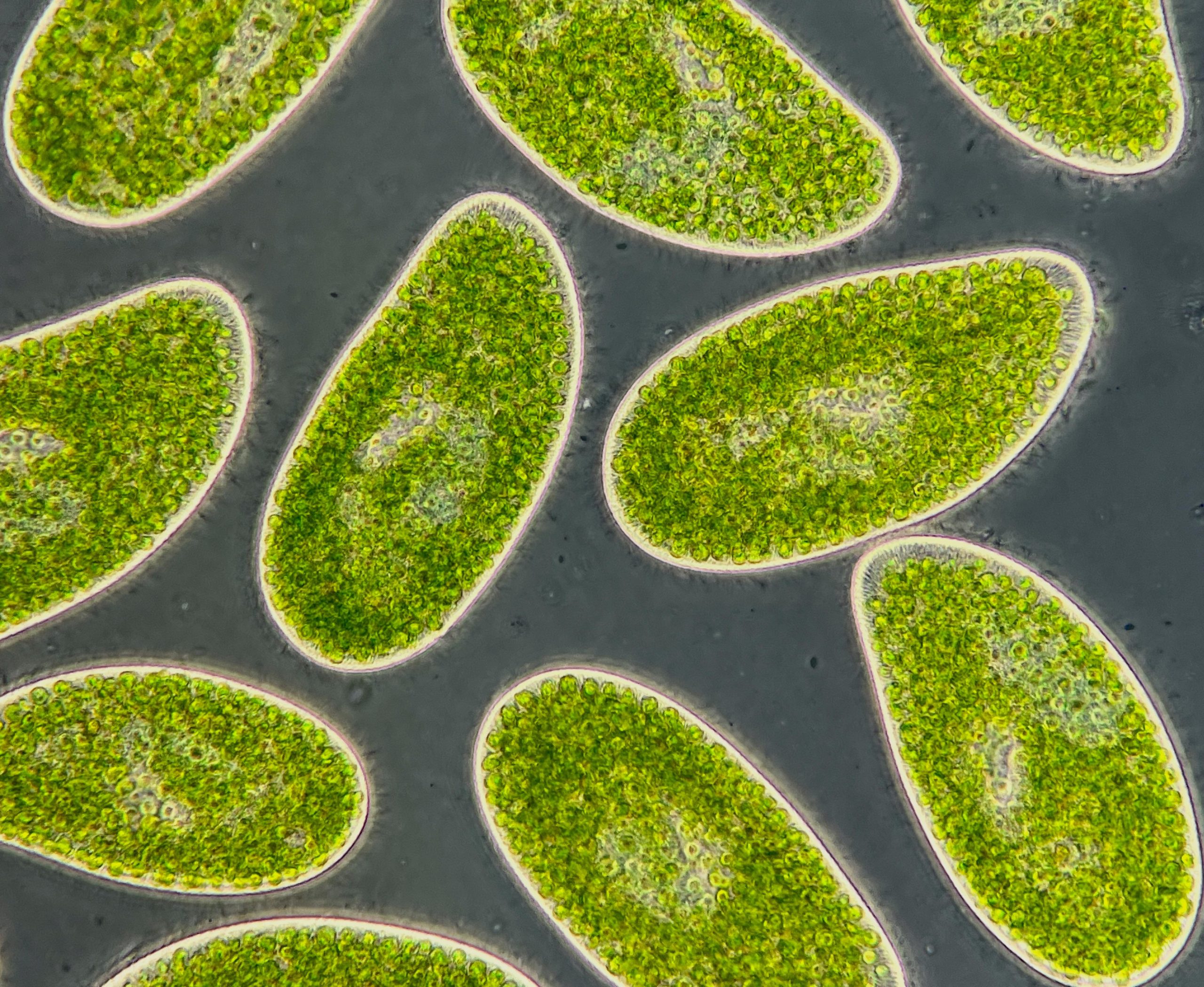

Encontrados en lagos y ríos de todo el mundo, criaturas unicelulares como estas Paramecio bursaria Puede comer y realizar la fotosíntesis. Los microbios como estos desempeñan un papel doble en el cambio climático, ya que liberan o absorben dióxido de carbono, el gas de efecto invernadero que atrapa el calor y es el principal impulsor del calentamiento, dependiendo de si adoptan un estilo de vida similar al de los animales o el de las plantas. Crédito: Daniel J Wiczynski, Universidad de Duke
El aumento de los niveles de calor podría empujar al plancton oceánico y otros organismos unicelulares hacia el umbral de carbono, lo que podría exacerbar el calentamiento global. Sin embargo, estudios recientes sugieren que es posible identificar señales de advertencia tempranas antes de que estos organismos alcancen ese punto crítico.
Un grupo de científicos que realiza investigaciones sobre una clase de microbios generalizada, pero a menudo ignorada, ha descubierto un ciclo de retroalimentación climática que podría intensificar el calentamiento global. Sin embargo, este hallazgo tiene un lado positivo: también puede ser una señal de advertencia temprana.
Usando simulaciones por computadora, investigadores de la Universidad de Duke y la Universidad de California, Santa Bárbara, han demostrado que la gran mayoría del plancton oceánico global, junto con muchos organismos unicelulares que habitan en lagos, turberas y otros ecosistemas, pueden estar llegando a un punto de inflexión. punto. Aquí, en lugar de absorber dióxido de carbono, comienzan a hacer lo contrario. Este cambio es el resultado de la forma en que su metabolismo responde al calentamiento.
Debido a que el dióxido de carbono es un gas de efecto invernadero, esto a su vez puede aumentar las temperaturas, un ciclo de retroalimentación positiva que puede conducir a cambios rápidos, donde pequeñas cantidades de calentamiento tienen un gran impacto.
Pero al monitorear cuidadosamente su abundancia, podemos anticipar el punto de inflexión antes de que llegue aquí, informan los investigadores en un estudio publicado el 1 de junio en la revista Nature. ecología funcional.
En el nuevo estudio, los investigadores se centraron en un grupo de microorganismos llamados mixótrofos, llamados así porque combinan dos modos de metabolismo: pueden hacer la fotosíntesis como una planta o cazar comida como un animal, según las condiciones.
“Ellos son como[{” attribute=””>Venus fly traps of the microbial world,” said first author Daniel Wieczynski, a postdoctoral associate at Duke.
During photosynthesis, they soak up carbon dioxide, a heat-trapping greenhouse gas. And when they eat, they release carbon dioxide. These versatile organisms aren’t considered in most models of global warming, yet they play an important role in regulating climate, said senior author Jean P. Gibert of Duke.
Most of the plankton in the ocean — things like diatoms, dinoflagellates — are mixotrophs. They’re also common in lakes, peatlands, in damp soils, and beneath fallen leaves.
“If you were to go to the nearest pond or lake and scoop a cup of water and put it under a microscope, you’d likely find thousands or even millions of mixotrophic microbes swimming around,” Wieczynski said.
“Because mixotrophs can both capture and emit carbon dioxide, they’re like ‘switches’ that could either help reduce climate change or make it worse,” said co-author Holly Moeller, an assistant professor at the University of California, Santa Barbara.
To understand how these impacts might scale up, the researchers developed a mathematical model to predict how mixotrophs might shift between different modes of metabolism as the climate continues to warm.
The researchers ran their models using a 4-degree span of temperatures, from 19 to 23 degrees Celsius (66-73 degrees Fahrenheit). Global temperatures are likely to surge 1.5 degrees Celsius above pre-industrial levels within the next five years, and are on pace to breach 2 to 4 degrees before the end of this century.
The analysis showed that the warmer it gets, the more mixotrophs rely on eating food rather than making their own via photosynthesis. As they do, they shift the balance between carbon in and carbon out.
The models suggest that, eventually, we could see these microbes reach a tipping point — a threshold beyond which they suddenly flip from carbon sink to carbon source, having a net warming effect instead of a cooling one.
This tipping point is hard to undo. Once they cross that threshold, it would take significant cooling — more than one degree Celsius — to restore their cooling effects, the findings suggest.
But it’s not all bad news, the researchers said. Their results also suggest that it may be possible to spot these shifts in advance, if we watch out for changes in mixotroph abundance over time.
“Right before a tipping point, their abundances suddenly start to fluctuate wildly,” Wieczynski said. “If you went out in nature and you saw a sudden change from relatively steady abundances to rapid fluctuations, you would know it’s coming.”
Whether the early warning signal is detectable, however, may depend on another key factor revealed by the study: nutrient pollution.
Discharges from wastewater treatment facilities and runoff from farms and lawns laced with chemical fertilizers and animal waste can send nutrients like nitrate and phosphate into lakes and streams and coastal waters.
When Wieczynski and his colleagues included higher amounts of such nutrients in their models, they found that the range of temperatures over which the telltale fluctuations occur starts to shrink until eventually the signal disappears and the tipping point arrives with no apparent warning.
The predictions of the model still need to be verified with real-world observations, but they “highlight the value of investing in early detection,” Moeller said.
“Tipping points can be short-lived, and thus hard to catch,” Gibert said. “This paper provides us with a search image, something to look out for, and makes those tipping points — as fleeting as they may be — more likely to be found.”
Reference: “Mixotrophic microbes create carbon tipping points under warming” by Daniel J. Wieczynski, Holly V. Moeller and Jean P. Gibert, 31 May 2023, Functional Ecology.
DOI: 10.1111/1365-2435.14350
The study was funded by the Simons Foundation, the National Science Foundation, and the U.S. Department of Energy.

“Futuro ídolo adolescente. Explorador amigable. Alborotador. Especialista en música. Practicante ávido de las redes sociales. Solucionador de problemas”.





More Stories
Compensar el sueño los fines de semana puede reducir el riesgo de enfermedad cardíaca en una quinta parte: estudio | Cardiopatía
¿Cómo se hicieron los agujeros negros tan grandes y rápidos? La respuesta está en la oscuridad.
Una estudiante de la Universidad de Carolina del Norte se convertirá en la mujer más joven en cruzar las fronteras del espacio a bordo de Blue Origin